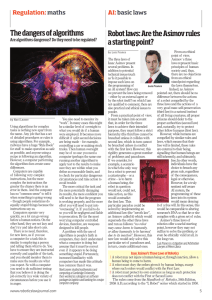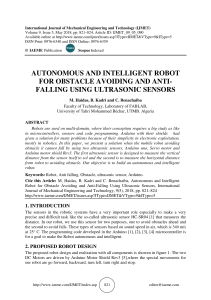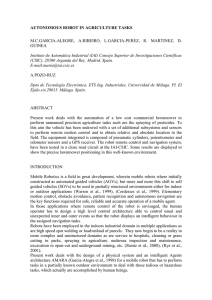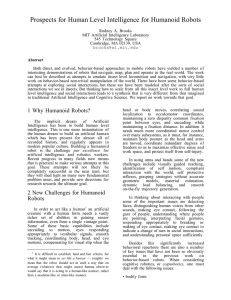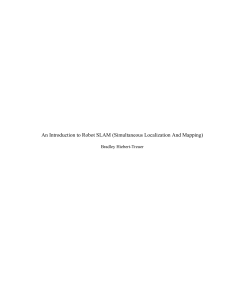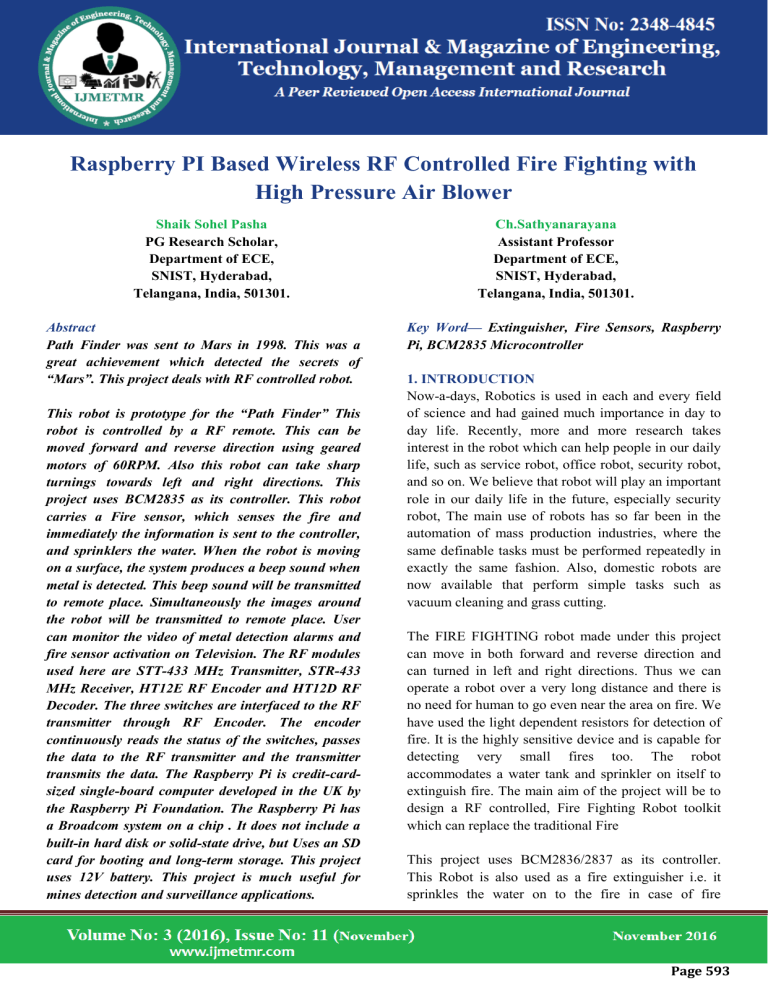
Raspberry PI Based Wireless RF Controlled Fire Fighting with High Pressure Air Blower Shaik Sohel Pasha PG Research Scholar, Department of ECE, SNIST, Hyderabad, Telangana, India, 501301. Abstract Path Finder was sent to Mars in 1998. This was a great achievement which detected the secrets of “Mars”. This project deals with RF controlled robot. This robot is prototype for the “Path Finder” This robot is controlled by a RF remote. This can be moved forward and reverse direction using geared motors of 60RPM. Also this robot can take sharp turnings towards left and right directions. This project uses BCM2835 as its controller. This robot carries a Fire sensor, which senses the fire and immediately the information is sent to the controller, and sprinklers the water. When the robot is moving on a surface, the system produces a beep sound when metal is detected. This beep sound will be transmitted to remote place. Simultaneously the images around the robot will be transmitted to remote place. User can monitor the video of metal detection alarms and fire sensor activation on Television. The RF modules used here are STT-433 MHz Transmitter, STR-433 MHz Receiver, HT12E RF Encoder and HT12D RF Decoder. The three switches are interfaced to the RF transmitter through RF Encoder. The encoder continuously reads the status of the switches, passes the data to the RF transmitter and the transmitter transmits the data. The Raspberry Pi is credit-cardsized single-board computer developed in the UK by the Raspberry Pi Foundation. The Raspberry Pi has a Broadcom system on a chip . It does not include a built-in hard disk or solid-state drive, but Uses an SD card for booting and long-term storage. This project uses 12V battery. This project is much useful for mines detection and surveillance applications. Ch.Sathyanarayana Assistant Professor Department of ECE, SNIST, Hyderabad, Telangana, India, 501301. Key Word— Extinguisher, Fire Sensors, Raspberry Pi, BCM2835 Microcontroller 1. INTRODUCTION Now-a-days, Robotics is used in each and every field of science and had gained much importance in day to day life. Recently, more and more research takes interest in the robot which can help people in our daily life, such as service robot, office robot, security robot, and so on. We believe that robot will play an important role in our daily life in the future, especially security robot, The main use of robots has so far been in the automation of mass production industries, where the same definable tasks must be performed repeatedly in exactly the same fashion. Also, domestic robots are now available that perform simple tasks such as vacuum cleaning and grass cutting. The FIRE FIGHTING robot made under this project can move in both forward and reverse direction and can turned in left and right directions. Thus we can operate a robot over a very long distance and there is no need for human to go even near the area on fire. We have used the light dependent resistors for detection of fire. It is the highly sensitive device and is capable for detecting very small fires too. The robot accommodates a water tank and sprinkler on itself to extinguish fire. The main aim of the project will be to design a RF controlled, Fire Fighting Robot toolkit which can replace the traditional Fire This project uses BCM2836/2837 as its controller. This Robot is also used as a fire extinguisher i.e. it sprinkles the water on to the fire in case of fire Page 593 accidents. At the same time even if any fire accident occurs the damage can be avoided by sprinkling water. If the fire is detected then the motor gets switched on which in turn switches on the water sprinkler (pump). The RF modules used here are Transmitter, Receiver, RF Encoder and RF Decoder. The switches are interfaced to the RF transmitter through RF Encoder. The encoder continuously reads the status of the switches, passes the data to the RF transmitter and the transmitter transmits the data. This project uses 12V battery. This project is much useful for mines detection and surveillance applications. 2. LITERATURE REVIEW Fire righting robot becomes an important topic this robot uses automatic technologies to detect fire and extinguish it paper [1] describes the technology development in robotics can be known from its type, shape and application. Robot can be used for high risk task such as firefighting. Firefighting robot should be able to search certain area, to detect and extinguish the flam. To complete this task, robot must be equipped with IR diode, photo diode, flam sensor. The firefighting robot is controlled by microcontroller avr at-mega 16. The stimulation area is designed in miniature .the miniature is equipped with furniture and uneven floor the technology used in [2] is GSM Modem. It describes if the temperature increases beyond the predetermined threshold value, buzzer sound to intimate the occurrence of fire accidents and a warning massage will be Send to the respective personnel in the industry and to nearby fire station with the GSM module provided it. Firefighting robot continuously monitors the temperature at four sensors and if fire accident is true, the robot moves to the directions to which the temperature is recorded to be the relatively maximum among the four sensors and extinguishes the fire with the water pump provided to it. After extinguishing the fire it comes back to its initial position. It is more advantageous than the smoke detector as it can extinguish the fire at the inception than waiting for an object to burn and produce smoke. This paper [3] describes a robot that constantly navigates to perceive any fire in its surroundings, if there is any fire it extinguishes it. This is meant to simulate the real world operation of a machine performing a fire extinguishing function at any workplace. The robot further sends message(s) to predefined numbers for alerting the user. 3. DESCRIPTION OF COMPONENTS 3.1 Microcontroller The Raspberry Pi is manufactured through licensed manufacturing deals with Newark element14 (Premier Farnell), RS Components and Egoman. All of these companies sell the Raspberry Pi online. Egoman produces a version for distribution solely in China and Taiwan, which can be distinguished from other Pis by their red colouring and lack of FCC/CE marks. The hardware is the same across all manufacturers. The pi has a Broadcom BCM2836 system on a chip (SoC), which includes an a quad-core Cortex-A7 cluster. The Cortex-A7 MP Core processor is a high-performance, low-power processor that implements the ARMv7-A architecture. The Cortex-A7 MP Core processor has one to four processors in a single multiprocessor device with a L1 cache subsystem, an optional integrated GIC, and an optional L2 cache controller. The Raspberry Pi foundation has finally released an upgraded version of the Raspberry Pi. Raspberry Pi 2 model B features much of the same ports and form factor as Raspberry Pi Model B+, by replaces Broadcom BCM2835 ARM11 processor @ 700 MHz with a much faster Broadcom BCM2836 quad core ARMv7 processor @ 900 MHz, and with an upgrade to 1GB RAM. SoC – Broadcom BCM2836 quad core Cortex A7 processor @ 900MHz with Video Core IV GPU System Memory – 1GB LPDDR2 Page 594 Storage – micro SD card slot (push release type) Video & Audio Output – HDMI and AV via 3.5mm jack. Connectivity – 10/100M Ethernet USB – 4x USB 2.0 ports, 1x micro USB for power Expansion a) 2×20 pin header for GPIOs b) Camera header c) Display header Power – 5V via micro USB port. Dimensions – 85 x 56 mm 3.3 Features of the Fire Sensing and Extinguishing Robot The fire sensors are capable of detecting fire from2 m away. The fire extinguisher works for a continuous time till the water tank becomes empty. The robot moves at 2.5 ft/sec on a flat surface, accelerate from 0 to 1 ft/sec in two seconds. The robot turns within a 6” radius and utilizes circular or octagon design in order to minimize possible impact area. Reporting through the SMS or E-mail. 3.4 Driver Circuit The driver circuit generally made by using one transistor and one relay. The driver circuit was mainly operated by the Micro Controller. The Micro Controller was change the state of the output pin from the low to high that is from O level to the 1 level. By using this sequence to control the base of the transistor. The transistor will act as a ON/OFF switch corresponding to the input of the base. If the base of the transistor wills high the transistor will act as a ON switch otherwise it will act as OFF switch 3.5 DC Motors DC motors are generally more powerful than servos in terms of speed and torque. Microcontroller could not accurately control DC motors without a motor controller. Therefore, motor Controllers are needed. An encoder used to get feedback from the DC motor. GPIO Pins 3.2 Electrical Components The uses 12V DC motors, Microcontroller, Fire extinguisher system will use a nominal voltage of 12.0V at most. The battery provides maximum power of 65 W and an average power of 7.8 Watts 3.6 Chassis Another word for chassis is base. All components of the robot are attached directly to the chassis; therefore a strong yet light chassis will be ideal. Chassis can be made from many different types of materials, some common types are aluminium, steel, acrylic, plastic, and high density polymer 4. WORKING Firefighting robot can be easily and conveniently used. Operate automatically when any fire occurs. Firefighting robot, has the ability to detect fire and Page 595 extinguish it. It detects the fire by means of fire sensor, fire sensor is a simple and compact device used for sensing the presence of fire. During any fire accident, hot gases are emitted with a unique spectral pattern in the IR region. It can be easily mounted on the robot body. It gives a high output on detecting a fire. An appropriate action can be taken based on this output The visual indication of output is provided by BCM2835 This robot is loaded with a water tanker and a pump controlled through wireless communication to sprinkle water. For the desired operation, an BCM2835 microcontroller is used. At the transmitter end, push buttons are used to send commands to the receiver end to control the robotic movement, either in forward, backward, right or left direction. The RF transmitter acts as an RF remote control that has the benefit of adequate range up to 200 meters with apposite antenna, while the decoder decode before feeding it to another microcontroller to drive DC motors via motor driver IC L293D for necessary work. A water tank with pump is placed on the robot body and its operation is carried out from the microcontroller o/p through the proper signal from the transmitting end. The entire operation is controlled by a microcontroller. Microcontroller could not accurately control DC motors without a motor controller. Therefore, motor Controllers are needed. So, here we use L293D motor driver IC. L293D is a typical Motor driver which allows DC motor to drive in both clockwise and anticlockwise direction. L293D is a 16-pin IC which can control a set of two DC motors simultaneously in any direction A motor driver IC is interfaced to the microcontroller through which the controller drives the motors. In future, this project can be developed by interfacing it with a wireless camera so that the person can view the controlling operation of the robot remotely on display Rechargeable batteries are used here. Rechargeable batteries produce after end of fire the robot will go back to its original position. 5. BLOCKDAIGRAM 5.1 Transmitter 5.2 Receiver Block diagram of automated firefighting robot with RF using BCM2835 microcontroller is as shown in figure. Flame sensors are connected to the processer which is the input block is use for the fire detecting purpose. There are two dc motors which are used in firefighting robot. Microcontroller gives output in few milli amperes (500ma), it is not enough to drive the high power devices such as dc motor. Hence to amplify these output i.e. well enough to drive a motor driver L293D IC is used. Which is the output block, one L293D IC operates the DC motors. The last block of the block diagram of automated firefighting robot with water pump, here water pump is used to sprinkle the water Page 596 on burnt who will extinguish the fire 6. CIRCUIT DIAGRAM 8. CONCLUSION The conclusion is to provide security of home, laboratory, office, factory and building which is important to human life. We develop an intelligent multisensory based security system that contains a firefighting system in our daily life. We design the fire detection system, and program the fire detection and fighting procedure using sensor based method Transmitter 9. FUTURE SCOPE In the present condition it can extinguish fire only in the way and not in all the rooms. It can be extended to a real fire extinguisher by replacing the water carrier by carbon-di-oxide carrier and by making it to extinguish fire of all the room using microcontroller programming. Also the robot could not be run through the batteries because at some condition the current requirements for the circuit rises to about 8A which is very high and cannot be obtained using batteries. Receiver 10. REFERNCES [1] The Intelligent Fire Fighting Robot Kristi Kosasih, E. Merry Sartika, M. Jimmy Hasugin, dan MulidyDepartment of Electrical Engneering,Maranatha Christian University J1.Prof.Drg. Suria Sumantri, 7. ADVANTAGES AND DISADVANTAGES 7.1 Advantages Prevention from dangerous incidents Minimization of ecological consequences financial loss threaten to a human life It provides security to houses, laboratories, offices, factories and buildings, etc It provides us greater efficiency to detect the flame and it can be extinguish before uncontrollable and threat life. 7.2 Disadvantages Doesn’t Predict or interfere with Operator thoughts Cannot force directly the operator to work The existing systems major drawback is that if the fire is small and limited to a small area, still the sprinklers are on for the whole area, this results in waste of water [2] A Fully Automated Fire Fighting Robot, Aman Sharma,1239,sector 9a,Gurgaon, Haryana – 122001 [3] Automatic Fire Sensing And Extinguishig Robot Embedded With Gsm Modem, U.Jyostna Sai Prasanna, M.V.D.Prasad, International Journal of Engineering and Advanced Technology, (IJEAT) ISSN: 2249 – 8958, Volume-2, Issue-4,April2013 [4] Rohith Punuganti, Anusha Srinivas, Lakshmi F Savanoor, Divya Shreer,” Pic Based Fire Sensing And Extinguishing Robot.”Proceedings of IRF International Conference, 30th March-2014, Pune, India, ISBN: 978- 93-82702-69-6 [5] Dr.Wael R. Abdulmajeed; Dr.Ali I.Mahdi; Karzan M Taqi, “Human Wireless Controlling Fire Fighting Page 597 Robot (Ffr) With 3-Axis Hose.” International Journal of Advanced Computer Technology (IJACT) ISSN: 2319- 7900 [6] K. Young-Duk, K. Jeon-Ho, S. Duk-Han, M. JeonIl, R. Young-Sun, and A. Jinung, "Design and implementation of user friendly remote controllers for rescue robots in fire sites," in SICE Annual Conference 2010, Proceedings of,ed, 2010, pp. 875880 Page 598

